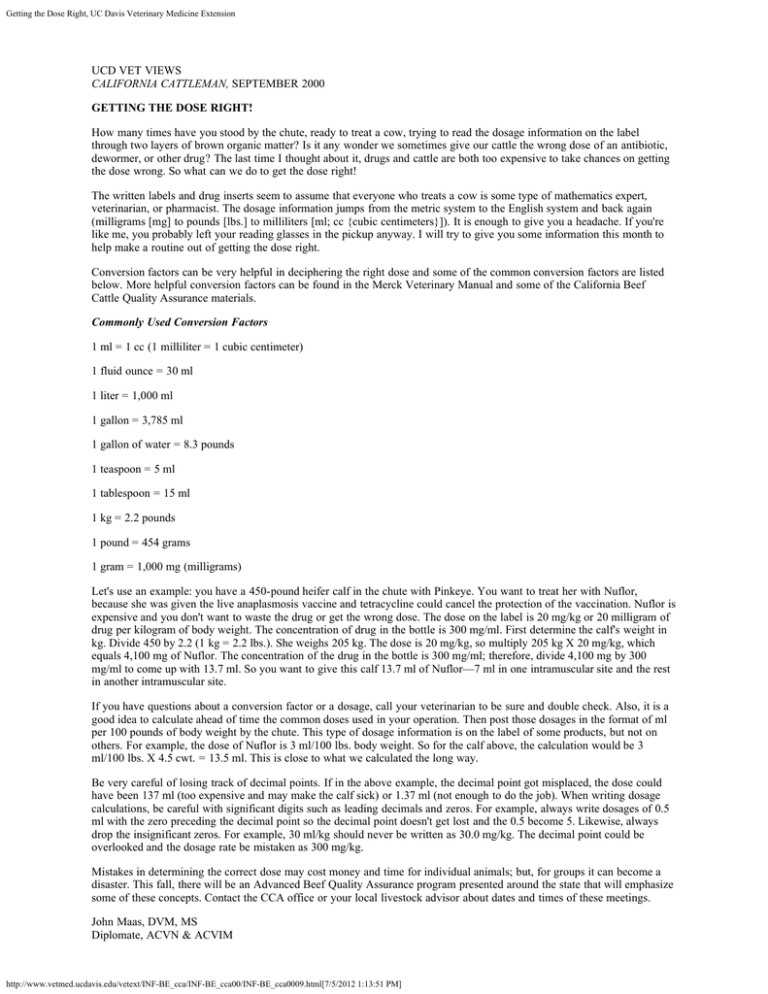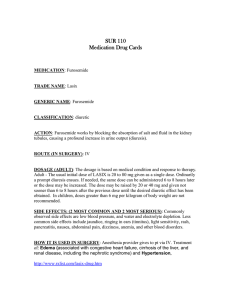
Getting the Dose Right, UC Davis Veterinary Medicine Extension
UCD VET VIEWS
CALIFORNIA CATTLEMAN, SEPTEMBER 2000
GETTING THE DOSE RIGHT!
How many times have you stood by the chute, ready to treat a cow, trying to read the dosage information on the label
through two layers of brown organic matter? Is it any wonder we sometimes give our cattle the wrong dose of an antibiotic,
dewormer, or other drug? The last time I thought about it, drugs and cattle are both too expensive to take chances on getting
the dose wrong. So what can we do to get the dose right!
The written labels and drug inserts seem to assume that everyone who treats a cow is some type of mathematics expert,
veterinarian, or pharmacist. The dosage information jumps from the metric system to the English system and back again
(milligrams [mg] to pounds [lbs.] to milliliters [ml; cc {cubic centimeters}]). It is enough to give you a headache. If you're
like me, you probably left your reading glasses in the pickup anyway. I will try to give you some information this month to
help make a routine out of getting the dose right.
Conversion factors can be very helpful in deciphering the right dose and some of the common conversion factors are listed
below. More helpful conversion factors can be found in the Merck Veterinary Manual and some of the California Beef
Cattle Quality Assurance materials.
Commonly Used Conversion Factors
1 ml = 1 cc (1 milliliter = 1 cubic centimeter)
1 fluid ounce = 30 ml
1 liter = 1,000 ml
1 gallon = 3,785 ml
1 gallon of water = 8.3 pounds
1 teaspoon = 5 ml
1 tablespoon = 15 ml
1 kg = 2.2 pounds
1 pound = 454 grams
1 gram = 1,000 mg (milligrams)
Let's use an example: you have a 450-pound heifer calf in the chute with Pinkeye. You want to treat her with Nuflor,
because she was given the live anaplasmosis vaccine and tetracycline could cancel the protection of the vaccination. Nuflor is
expensive and you don't want to waste the drug or get the wrong dose. The dose on the label is 20 mg/kg or 20 milligram of
drug per kilogram of body weight. The concentration of drug in the bottle is 300 mg/ml. First determine the calf's weight in
kg. Divide 450 by 2.2 (1 kg = 2.2 lbs.). She weighs 205 kg. The dose is 20 mg/kg, so multiply 205 kg X 20 mg/kg, which
equals 4,100 mg of Nuflor. The concentration of the drug in the bottle is 300 mg/ml; therefore, divide 4,100 mg by 300
mg/ml to come up with 13.7 ml. So you want to give this calf 13.7 ml of Nuflor—7 ml in one intramuscular site and the rest
in another intramuscular site.
If you have questions about a conversion factor or a dosage, call your veterinarian to be sure and double check. Also, it is a
good idea to calculate ahead of time the common doses used in your operation. Then post those dosages in the format of ml
per 100 pounds of body weight by the chute. This type of dosage information is on the label of some products, but not on
others. For example, the dose of Nuflor is 3 ml/100 lbs. body weight. So for the calf above, the calculation would be 3
ml/100 lbs. X 4.5 cwt. = 13.5 ml. This is close to what we calculated the long way.
Be very careful of losing track of decimal points. If in the above example, the decimal point got misplaced, the dose could
have been 137 ml (too expensive and may make the calf sick) or 1.37 ml (not enough to do the job). When writing dosage
calculations, be careful with significant digits such as leading decimals and zeros. For example, always write dosages of 0.5
ml with the zero preceding the decimal point so the decimal point doesn't get lost and the 0.5 become 5. Likewise, always
drop the insignificant zeros. For example, 30 ml/kg should never be written as 30.0 mg/kg. The decimal point could be
overlooked and the dosage rate be mistaken as 300 mg/kg.
Mistakes in determining the correct dose may cost money and time for individual animals; but, for groups it can become a
disaster. This fall, there will be an Advanced Beef Quality Assurance program presented around the state that will emphasize
some of these concepts. Contact the CCA office or your local livestock advisor about dates and times of these meetings.
John Maas, DVM, MS
Diplomate, ACVN & ACVIM
http://www.vetmed.ucdavis.edu/vetext/INF-BE_cca/INF-BE_cca00/INF-BE_cca0009.html[7/5/2012 1:13:51 PM]
Getting the Dose Right, UC Davis Veterinary Medicine Extension
Extension Veterinarian
School of Veterinary Medicine
University of California, Davis
Home | Beef Cattle Programs | FAQ/Beef | INFO/Beef | Top
Your support of the School of Veterinary Medicine makes a difference
Contact us | Animal Health Inquiries | Check us out on Facebook, Twitter, & YouTube | Online Donation Form | Site Map
UC Davis School of Veterinary Medicine • One Shields Avenue • Davis, CA 95616
Copyright © The Regents of the University of California, Davis campus. All Rights Reserved.
http://www.vetmed.ucdavis.edu/vetext/INF-BE_cca/INF-BE_cca00/INF-BE_cca0009.html[7/5/2012 1:13:51 PM]




